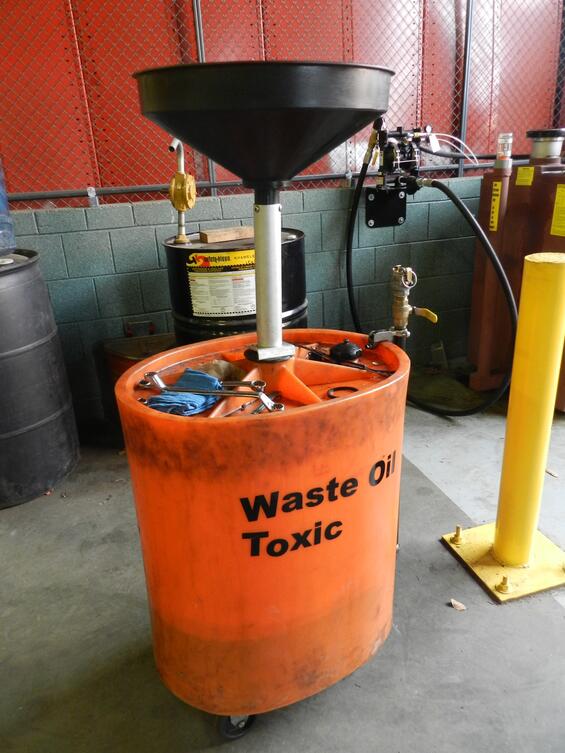Options for Vehicle Fluid Collection
Self-Evacuating Used Oil and Antifreeze Drains
Many shops use self-evacuating oil and antifreeze drains to cleanly and quickly evacuate fluids from a car. See the “Antifreeze Recycling” fact sheet to learn about options for antifreeze management. In the self-evacuating oil and antifreeze drains, the fluid is allowed to drain from the vehicle and flow through the funnel, collecting in the caddy’s small temporary storage tank. To evacuate the tank, it is connected to an air supply that can push the fluid from the tank into a hazardous waste collection barrel or tank designated for that type of waste using an air-tight connection. See the “Hazardous Waste Management” fact sheet.
Oil Lift Drains
Oil lift drains often appear similar to the self-evacuating oil drains. However, the more basic oil lift drains need to be slowly emptied and allowed to drain into a waste collection barrel instead of using shop air to quickly empty it. This leads to less spills than using a drip pan (described below) but takes more time than using the self-evacuating version.
Drip Pans
Using a drip pan is the cheapest and simplest option for spill prevention while working on a car that could drip fluids, but far less effective at preventing spills than the methods described above. Most supply companies sell basic drip pans. After a drip pan is used, workers transfer the fluid to hazardous waste collection drums. The drip pans need to drain for at least 12 hours in order to be sure that enough oil has drained from them. See the “Waste Oil Management” fact sheet in this guide.

This waste oil caddy can be wheeled over to an oil collection tank and drained directly into the tank using an air supply.
The Benefits
Prevent Spills
Oil capturing techniques outlined above, particularly those that use self-evacuating technology, are effective at preventing spills and drips onto the shop floor. Using these techniques reduce the need to clean up spills. See the “Spill Prevention and Cleanup” fact sheet for more information.
Improve Ease of Hazardous Waste Management
Drip pans don’t necessarily improve the ease of hazardous waste management. When used, the oil or other fluid still must be emptied into a collection barrel and the pan drained for at least 12 hours (in the case of waste oil). See the “Waste Oil Management” fact sheet for more information. However, self-evacuating models ensure that the waste fluid can be transferred from vehicles to collection barrels quickly and without spills. Also, both the oil lift drains and the self-evacuating variety have wheels that make transfer to a waste collection barrel easier.
Take the Next Step
- Contact the Massachusetts Office of Technical Assistance for free and confidential assistance (617) 626-1060.
- Ask other shop owners what their preferred methods are.
- Talk to suppliers about your options for fluid collection.
Contact
Phone
You will be connected to the person who can best answer your questions.